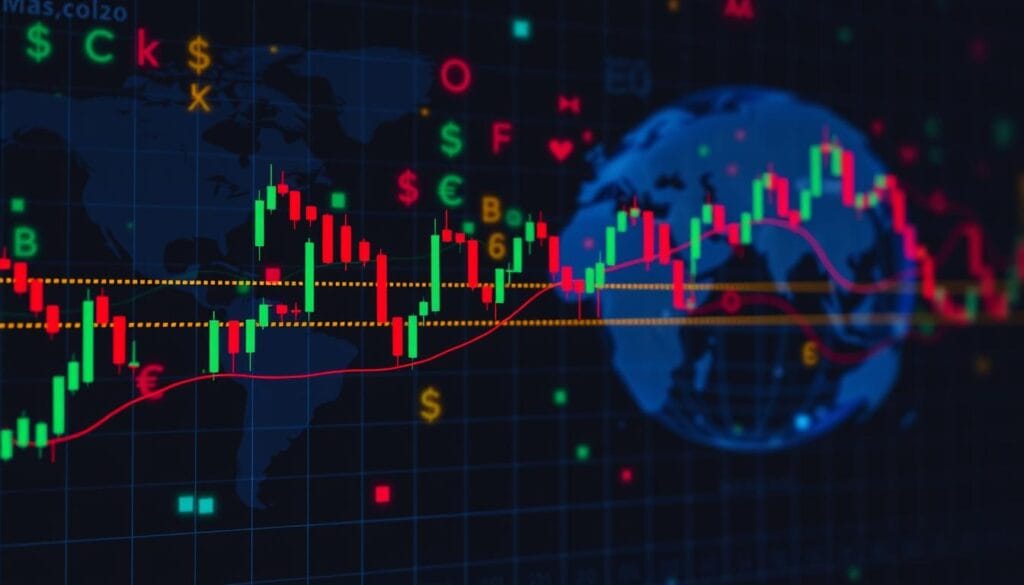Forex traders know the value of thorough analysis for making smart choices. This article explores key Forex analysis techniques to boost trading confidence and precision. We’ll dive into fundamental, technical, and sentiment analysis to enhance your trading strategies.
טייק אווי מפתח
- Forex analysis encompasses a range of techniques, including fundamental, technical, and sentiment analysis, to uncover valuable market insights.
- Understanding the different types of Forex analysis and their importance can help traders make more informed החלטות מסחר.
- ניתוח יסודי examines אינדיקטורים כלכליים and political/geopolitical factors that influence currency valuations.
- ניתוח טכני focuses on the study of price movements, trends, and patterns to identify potential trading opportunities.
- Sentiment analysis provides insights into the overall market sentiment, which can inform trading strategies and risk management.
Understanding Forex Market Analysis
ה שוק המט"ח is dynamic and complex. To navigate it well, traders need to understand various analysis techniques. These include fundamental, technical, and sentiment analysis.
Each method offers unique insights into the market. They help traders make better decisions and improve their strategies. Combining these approaches can lead to more successful trading.
Types of Forex Analysis
ניתוח יסודי looks at economic and political factors. These include interest rates, inflation, and geopolitical events. They all affect currency values.
ניתוח טכני studies past market data. It focuses on price movements, trends, and patterns. This helps predict future price behavior.
Sentiment analysis examines market psychology. It provides insights into overall market sentiment. This can help predict potential price movements.
| Analysis Type | מאפיינים מרכזיים | Applications |
|---|---|---|
| Fundamental Analysis | Focuses on economic and political factors | Identifying long-term trends, assessing currency valuations |
| Technical Analysis | Examines historical price and volume data | Identifying short-term trading opportunities, recognizing market patterns |
| Sentiment Analysis | Measures the overall market mood and psychology | Anticipating potential price movements, gauging market volatility |
Importance of Forex Analysis
יָעִיל Forex analysis is key to successful trading. It helps traders understand market dynamics better. This leads to identifying potential opportunities and managing risks.
Using a mix of analysis techniques empowers traders. They can make informed decisions and achieve more profitable outcomes. This approach supports sustainable trading in the long run.
Forex Fundamental Analysis
Fundamental analysis is key to making smart מסחר במט"ח choices. It looks at economic, political, and global factors affecting currency values. This approach helps traders understand market forces shaping currency changes.
By grasping these drivers, traders can make better decisions in the שוק המט"ח. They can navigate the complex world of global currencies more effectively.
Economic Indicators
אינדיקטורים כלכליים reveal an economy’s health and direction. Forex traders watch several key אינדיקטורים closely.
- Gross Domestic Product (GDP): A measure of a country’s economic output and growth.
- Inflation rates: The rate at which the general price level of goods and services increases over time.
- Interest rates: The cost of borrowing money, which can significantly impact currency values.
- Employment figures: The level of employment and unemployment in an economy.
- Trade balances: The difference between a country’s imports and exports.
Political and Geopolitical Factors
Political and global events also impact currency markets. Traders must consider these factors too.
- Government policies and regulations: Changes in fiscal and monetary policies can affect currency values.
- Geopolitical tensions and conflicts: Global events, such as wars, trade disputes, or diplomatic crises, can trigger volatility in currency markets.
- Political stability: The overall political climate and leadership changes can influence investor confidence and currency movements.
Combining economic and political factors gives traders a fuller picture. This knowledge helps them make smarter trading choices.
It also helps traders navigate the complex שוק המט"ח more effectively. Understanding these factors is crucial for success in מסחר במטבעות.
| Economic Indicator | Potential Impact on Forex |
|---|---|
| Gross Domestic Product (GDP) | Strong GDP growth can strengthen a currency, while weak GDP can lead to currency depreciation. |
| Inflation | High inflation can erode a currency’s purchasing power, leading to depreciation. |
| Interest Rates | Increases in interest rates can attract foreign investment and strengthen the currency, while decreases can weaken it. |
| Trade Balance | A positive trade balance (more exports than imports) can boost a currency, while a negative balance can lead to currency depreciation. |
“Understanding the fundamental factors driving the forex market is essential for making informed החלטות מסחר and navigating the complexities of the global currency landscape.”
Forex Technical Analysis
Forex technical analysis is a powerful tool for traders. It provides insights into market trends and trading opportunities. Traders can make informed decisions by studying past price movements, דפוסי תרשים, and technical אינדיקטורים.
תבניות תרשים are crucial in forex technical analysis. These visual formations can signal market reversals or continuations. Traders who recognize דפוסי תרשים can identify better entry and exit points.
אינדיקטורים טכניים are also vital in forex analysis. They help traders identify trend direction and strength. Indicators can also show overbought or oversold conditions. Combining multiple indicators gives a more comprehensive market understanding.
Price action הוא היבט מרכזי נוסף של forex technical analysis. It focuses on the behavior of price itself. This approach analyzes candlestick patterns and support and resistance levels.
מאסטרינג forex technical analysis gives traders a market advantage. It helps them make more confident החלטות מסחר. This skill can enhance their chances of success in the שוק המט"ח.
“Technical analysis is a tool, but it’s not a crystal ball. It’s designed to help you understand the emotions in the market, not to predict the future.”
– John J. Murphy, author of “Technical Analysis of the Financial Markets”

Forex Analysis
Forex analysis is crucial for successful trading in the foreign exchange market. It involves studying market data, אינדיקטורים כלכליים, and analytical techniques. Traders use this to interpret trends, spot opportunities, and make smart decisions.
Forex analysis combines different types of data to recognize patterns for trading strategies. Traders interpret fundamental factors like economic reports and technical indicators such as price movements. This balanced approach helps develop a well-rounded view of the market.
Interpreting Market Data
יָעִיל forex analysis requires attention to detail and insight extraction from market data. Traders analyze economic indicators to assess the economy’s health. These indicators include GDP growth, inflation rates, and employment figures.
- Identify and interpret key economic reports and announcements
- Understand the relationship between macroeconomic factors and currency movements
- Recognize how political and geopolitical events can influence market sentiment and exchange rates
Recognizing Patterns and Trends
Successful forex traders also use technical analysis to spot market patterns and trends. They study historical price data, דפוסי תרשים, and momentum indicators. This helps them predict the likely direction of currency pairs.
- Identify and interpret common technical analysis patterns, such as support and resistance levels, trendlines, and candlestick formations
- Utilize technical indicators, like moving averages, relative strength index (RSI), and Bollinger Bands, to inform trading decisions
- Recognize and respond to changes in market sentiment and volatility
Combining fundamental and technical ניתוח שוק gives traders a complete view of the forex market. This approach to data interpretation helps unlock the foreign exchange market’s potential. It leads to more informed החלטות מסחר.

"מוּצלָח מסחר במט"ח is not about predicting the future, but about understanding the present and making informed decisions based on the available data.”
Sentiment Analysis in the Forex Market
Forex sentiment analysis is key for making smart trading choices. It reveals traders’ mindsets, helping predict market shifts. This insight allows traders to adjust their strategies effectively.
Measuring Market Sentiment
Forex traders use various indicators to gauge market sentiment. These tools provide a clear picture of the market’s mood.
- Trader Positioning Data: Analyzing positions of different trader groups reveals overall market sentiment.
- Investor Sentiment Surveys: These capture the views of various market participants. They offer a broad view of market mood.
- Volatility Indices: These measure market volatility. They show investor fear and uncertainty levels.
- Social Media and News Analysis: This helps gauge market psychology. It involves monitoring sentiment on social platforms and financial news.
Using these indicators together gives traders a deeper grasp of market emotions. This knowledge leads to more informed trading decisions.
| Sentiment Indicator | תֵאוּר | פֵּשֶׁר |
|---|---|---|
| Trader Positioning Data | Analysis of the positions held by different trader groups | Reveals the overall market sentiment, with a high percentage of long positions indicating bullish sentiment and a high percentage of short positions indicating bearish sentiment. |
| Investor Sentiment Surveys | Surveys that capture the sentiment of individual investors, institutional traders, and other market participants | Provides a comprehensive view of the prevailing market mood, with high levels of optimism suggesting bullish sentiment and high levels of pessimism suggesting bearish sentiment. |
| Volatility Indices | Measures of market volatility, such as the VIX (Volatility Index) | Serve as proxies for investor fear and uncertainty, with high volatility indicating a bearish sentiment and low volatility indicating a bullish sentiment. |
| Social Media and News Analysis | Monitoring the sentiment expressed on social media platforms and in financial news | Helps gauge the overall market psychology, with positive sentiment suggesting bullish sentiment and negative sentiment suggesting bearish sentiment. |

“Understanding market sentiment is like reading the pulse of the forex market. It provides invaluable insights that can help traders navigate the ever-changing landscape with greater confidence.”
Risk Management Strategies
יָעִיל ניהול סיכונים is crucial for long-term success in מסחר במט"ח. Savvy traders use ניהול סיכונים במט"ח, הפחתת סיכונים, and strategic גודל מיקום. These tools help protect capital and navigate market uncertainties.
Position Sizing: The Key to Controlled Exposure
גודל מיקום is a key ניהול סיכונים strategy in Forex. It involves choosing the right trade size based on account balance and risk tolerance. This approach limits downside exposure and minimizes potential losses.
Stop-Loss Orders: The Safety Net
פקודות סטופ-לוס are vital for forex risk mitigation. They automatically close trades at predetermined price levels. This prevents uncontrolled losses and protects traders’ capital effectively.
Leverage Management: Balancing Opportunity and Risk
Leverage in Forex trading can amplify both profits and losses. Leverage management is a critical part of ניהול סיכונים. Traders must assess their risk tolerance and adjust leverage to avoid excessive exposure.
“The key to successful Forex trading is not just about identifying profitable opportunities, but also effectively managing the inherent risks.” – Jane Doe, Chief Investment Officer
Incorporating these risk management strategies helps Forex traders navigate market complexities. It enhances their chances of long-term success and builds confidence in their trading approach.
Developing a Trading Plan
A well-structured trading plan is vital for long-term success in the Forex market. This section explores key components of a comprehensive trading plan. You’ll learn how to create a disciplined approach to Forex trading.
Goal Setting
Clear, measurable goals form the foundation of a solid trading plan. Set SMART objectives to guide your Forex trading journey. These goals should align with your risk tolerance and investment strategy.
SMART stands for Specific, Measurable, Achievable, Relevant, and Time-bound. Your goals might include generating a monthly return or improving your win-rate. Focus on what’s important to you.
Backtesting Strategies
Before going live, thoroughly backtest your strategies using historical data. This process helps optimize your Forex trading system and identify its strengths and weaknesses. You’ll gain insights into how your strategies perform in various market conditions.
Backtesting allows you to refine your trading plan and improve entry and exit points. It also enhances your overall trading discipline. Take time to test and adjust before risking real money.













